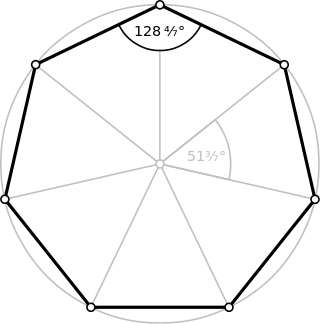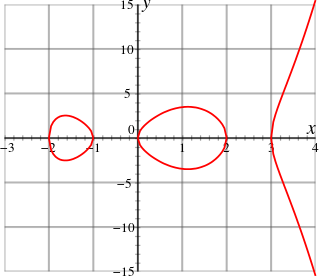In mathematical analysis, a metric space M is called complete if every Cauchy sequence of points in M has a limit that is also in M.

In mathematics, a field is a set on which addition, subtraction, multiplication, and division are defined and behave as the corresponding operations on rational and real numbers. A field is thus a fundamental algebraic structure which is widely used in algebra, number theory, and many other areas of mathematics.
ML is a functional programming language. It is known for its use of the polymorphic Hindley–Milner type system, which automatically assigns the data types of most expressions without requiring explicit type annotations, and ensures type safety; there is a formal proof that a well-typed ML program does not cause runtime type errors. ML provides pattern matching for function arguments, garbage collection, imperative programming, call-by-value and currying. While a general-purpose programming language, ML is used heavily in programming language research and is one of the few languages to be completely specified and verified using formal semantics. Its types and pattern matching make it well-suited and commonly used to operate on other formal languages, such as in compiler writing, automated theorem proving, and formal verification.
In theoretical computer science and formal language theory, a regular language is a formal language that can be defined by a regular expression, in the strict sense in theoretical computer science.
In mathematics, a continued fraction is an expression obtained through an iterative process of representing a number as the sum of its integer part and the reciprocal of another number, then writing this other number as the sum of its integer part and another reciprocal, and so on. In a finite continued fraction, the iteration/recursion is terminated after finitely many steps by using an integer in lieu of another continued fraction. In contrast, an infinite continued fraction is an infinite expression. In either case, all integers in the sequence, other than the first, must be positive. The integers are called the coefficients or terms of the continued fraction.
Arrow's impossibility theorem is a key impossibility theorem in social choice theory, showing that no ranked voting rule can produce a logically coherent ranking of more than two candidates. Specifically, no such rule can satisfy a key criterion of rational choice called independence of irrelevant alternatives: that a choice between and should not depend on the quality of a third, unrelated outcome .

Faltings's theorem is a result in arithmetic geometry, according to which a curve of genus greater than 1 over the field of rational numbers has only finitely many rational points. This was conjectured in 1922 by Louis Mordell, and known as the Mordell conjecture until its 1983 proof by Gerd Faltings. The conjecture was later generalized by replacing by any number field.

In calculus, Rolle's theorem or Rolle's lemma essentially states that any real-valued differentiable function that attains equal values at two distinct points must have at least one stationary point somewhere between them—that is, a point where the first derivative is zero. The theorem is named after Michel Rolle.

In number theory, the study of Diophantine approximation deals with the approximation of real numbers by rational numbers. It is named after Diophantus of Alexandria.
In mathematics, Diophantine geometry is the study of Diophantine equations by means of powerful methods in algebraic geometry. By the 20th century it became clear for some mathematicians that methods of algebraic geometry are ideal tools to study these equations. Diophantine geometry is part of the broader field of arithmetic geometry.
In mathematics, a rational variety is an algebraic variety, over a given field K, which is birationally equivalent to a projective space of some dimension over K. This means that its function field is isomorphic to

In mathematics, arithmetic geometry is roughly the application of techniques from algebraic geometry to problems in number theory. Arithmetic geometry is centered around Diophantine geometry, the study of rational points of algebraic varieties.
In the mathematical field of mathematical analysis, Lusin's theorem or Lusin's criterion states that an almost-everywhere finite function is measurable if and only if it is a continuous function on nearly all its domain. In the informal formulation of J. E. Littlewood, "every measurable function is nearly continuous".
In game theory, folk theorems are a class of theorems describing an abundance of Nash equilibrium payoff profiles in repeated games. The original Folk Theorem concerned the payoffs of all the Nash equilibria of an infinitely repeated game. This result was called the Folk Theorem because it was widely known among game theorists in the 1950s, even though no one had published it. Friedman's (1971) Theorem concerns the payoffs of certain subgame-perfect Nash equilibria (SPE) of an infinitely repeated game, and so strengthens the original Folk Theorem by using a stronger equilibrium concept: subgame-perfect Nash equilibria rather than Nash equilibria.
This is a glossary of arithmetic and diophantine geometry in mathematics, areas growing out of the traditional study of Diophantine equations to encompass large parts of number theory and algebraic geometry. Much of the theory is in the form of proposed conjectures, which can be related at various levels of generality.

In complex analysis, Runge's theorem is named after the German mathematician Carl Runge who first proved it in the year 1885. It states the following:
Foster's reactance theorem is an important theorem in the fields of electrical network analysis and synthesis. The theorem states that the reactance of a passive, lossless two-terminal (one-port) network always strictly monotonically increases with frequency. It is easily seen that the reactances of inductors and capacitors individually increase with frequency and from that basis a proof for passive lossless networks generally can be constructed. The proof of the theorem was presented by Ronald Martin Foster in 1924, although the principle had been published earlier by Foster's colleagues at American Telephone & Telegraph.
In mathematics, the Mordell–Weil theorem states that for an abelian variety over a number field , the group of K-rational points of is a finitely-generated abelian group, called the Mordell–Weil group. The case with an elliptic curve and the field of rational numbers is Mordell's theorem, answering a question apparently posed by Henri Poincaré around 1901; it was proved by Louis Mordell in 1922. It is a foundational theorem of Diophantine geometry and the arithmetic of abelian varieties.
In mathematics, Niven's theorem, named after Ivan Niven, states that the only rational values of θ in the interval 0° ≤ θ ≤ 90° for which the sine of θ degrees is also a rational number are:
In order theory and model theory, branches of mathematics, Cantor's isomorphism theorem states that every two countable dense unbounded linear orders are order-isomorphic. For instance, Minkowski's question-mark function produces an isomorphism between the numerical ordering of the rational numbers and the numerical ordering of the dyadic rationals.





